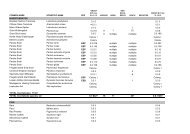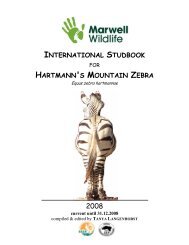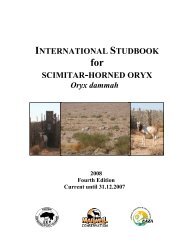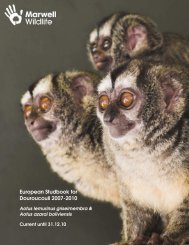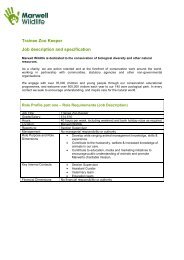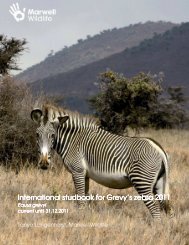Information and Communication Technology - Marwell Zoo
Information and Communication Technology - Marwell Zoo
Information and Communication Technology - Marwell Zoo
You also want an ePaper? Increase the reach of your titles
YUMPU automatically turns print PDFs into web optimized ePapers that Google loves.
inspire<br />
educate<br />
imagine<br />
enjoy<br />
conserve<br />
believe<br />
care<br />
<strong>Information</strong> <strong>and</strong><br />
<strong>Communication</strong><br />
<strong>Technology</strong><br />
010101010110<br />
Education Service
Contents<br />
An Introduction to <strong>Marwell</strong> <strong>Zoo</strong>logical Park<br />
A Profile of <strong>Marwell</strong> <strong>Zoo</strong> <strong>and</strong> <strong>Marwell</strong> Preservation Trust<br />
The Organisation<br />
Departments at <strong>Marwell</strong><br />
Income <strong>and</strong> Expenditure<br />
The <strong>Communication</strong>s Department<br />
The use of ICT within the Business<br />
ICT <strong>and</strong> <strong>Communication</strong> with Customers<br />
Screen Captures of ICT Programmes used at <strong>Marwell</strong><br />
ARKS <strong>and</strong> ISIS Database Screen Captures<br />
Membership <strong>and</strong> Volunteer Database Screen Capture<br />
PM 2000 Screen Capture<br />
Ark Gift Shop Sales Group Graph<br />
<strong>Marwell</strong>’s Technical Specifications<br />
Specimen ARKS Report Sheet
An Introduction to<br />
In 1969, Mr John Knowles bought <strong>Marwell</strong> Hall <strong>and</strong> the surrounding estate to set up a centre for the<br />
preservation of animal species in danger of becoming extinct. The first animals to arrive were a pair<br />
of Amur tigers.<br />
Background<br />
In 2006 the International Union for Conservation of Nature (IUCN) listed 7725 species of animal as<br />
being threatened with extinction (http://www.iucnredlist.org). It is very difficult to estimate the total<br />
number of all species of animals threatened because many are not yet known to man <strong>and</strong> others<br />
have not yet been evaluated, or there is limited data available. Over 1 million species of animal are<br />
known to man, but there are probably many more.<br />
Extinctions are caused primarily by the ever-increasing dem<strong>and</strong>s of the human population. Pollution,<br />
habitat destruction <strong>and</strong> hunting can all result in the loss of species.<br />
Extinction of species matters to humans for a number of reasons:<br />
a) All living things are interdependent – they depend on each other in a number of ways. We<br />
should not upset the balance of nature – we have no idea what the consequences might be.<br />
b) It is morally wrong to intentionally cause a species to become extinct.<br />
c) Some plants <strong>and</strong> animal species have a practical value for humans, for example in farming<br />
or medicines. If we destroy them, we will never realise their true value.<br />
d) Academic knowledge – pure study can often lead to practical benefits.<br />
Conservation is the protection <strong>and</strong> wise use of anything we want to keep. If we are to safeguard the<br />
future of many animal species in the wild, we must be more careful in our use of l<strong>and</strong> <strong>and</strong><br />
resources. Without suitable habitats animals cannot survive.<br />
Our Aims<br />
a) Conservation Breeding: to breed animals to ensure the species does not become extinct.<br />
Sometimes captive-bred animals can be re-introduced to the wild.<br />
b) Outreach: to support in situ conservation projects, i.e. work going on in the animal’s natural<br />
habitat.<br />
c) Education: to stimulate concern about wildlife. If we cannot persuade people to alter their<br />
attitudes today, the rest of our conservation work is of debatable value.<br />
d) Research: to find out more about wild animal species. The more we know the better chance<br />
we will have of saving them.<br />
Conservation Breeding<br />
We must ensure that captive breeding populations are self-sustaining, i.e. they must breed enough<br />
to maintain numbers. If more animals die than are born each year, a species could become extinct<br />
in captivity too. Successful breeding depends on many things.<br />
Ideally animals should not breed with their close relatives. Where possible, matings should be<br />
between unrelated animals. This ensures that the species remains as healthy <strong>and</strong> as varied as<br />
possible. Sometimes animals are transferred between zoos for breeding. This can be difficult <strong>and</strong><br />
expensive, but the traveling time is always kept to a minimum.<br />
<strong>Marwell</strong>, like other zoos taking part in breeding programmes, must record as much information as is<br />
available about each individual animal involved. Records include details of sex, name, date of birth,<br />
parentage as well as veterinary particulars. To help identify individuals, ear-tags or electronic tags<br />
under the skin may be used.
The animals’ details are held on computerised studbooks. This information is used by studbook<br />
keepers <strong>and</strong> species co-coordinators to organise breeding programmes at a national, European <strong>and</strong><br />
global level. Participating zoos share responsibility for the work involved, <strong>and</strong> different organisations<br />
will hold different studbooks. <strong>Marwell</strong> organises the international or regional studbooks for Grevy’s<br />
zebra, Hartmann’s mountain zebra <strong>and</strong> scimitar-horned oryx.<br />
Breeding Successes<br />
Most species at <strong>Marwell</strong> breed successfully, but some are especially notable. In the UK, we were<br />
the first to breed nyala, addax, dama gazelle, maned wolf, secretary bird, babirusa, Somali wild ass<br />
<strong>and</strong> mishmi takin. Other important births include okapi, pygmy hippo <strong>and</strong> a white rhinoceros. This<br />
was a significant event for the captive breeding of this species as ‘Bhasela’ was the first full ‘second<br />
generation’ rhino bred in the UK.<br />
Re-introductions<br />
Re-introduction is not just a matter of releasing animals into the wild, but involves many complex<br />
factors. These include the availability of suitable habitat, the economic situation <strong>and</strong> willingness of<br />
the country concerned, the co-operation of the local people <strong>and</strong>, most importantly, the elimination of<br />
the threats, which made the species concerned rare in the first place. Education, habitat protection<br />
<strong>and</strong> research must go alongside re-introduction for it to succeed. Where this is possible there are<br />
great benefits not only to the species reintroduced, but also its habitat <strong>and</strong> all the other species that<br />
share that habitat.<br />
Although difficult, re-introduction has been successful for several species, <strong>and</strong> <strong>Marwell</strong> is proud to<br />
have played an important role in several programmes. These include cheer pheasants (to the<br />
Himalayan foothills in Pakistan), scimitar-horned oryx (to a reserve in Tunisia), golden lion tamarins<br />
(to a reserve in the Brazilian rain forest) <strong>and</strong> s<strong>and</strong> lizards, natterjack toads, water voles <strong>and</strong> reddish<br />
buff moths (to protected sites in the UK).<br />
Conservation Abroad<br />
The ideal situation, when possible, is to conserve animals in their natural habitats in their countries<br />
of origin (in situ conservation) <strong>and</strong> <strong>Marwell</strong> donates part of its income every year to support field<br />
conservation projects.<br />
A major commitment is the <strong>Marwell</strong> Zimbabwe Trust, based at the <strong>Marwell</strong> Dambari Field Station.<br />
This station is a base for conservation initiatives <strong>and</strong> research in southern Africa, including work with<br />
black rhino. In 2006 <strong>Marwell</strong> also supported a number of projects, including the work of the<br />
International Snow Leopard Trust <strong>and</strong> the Epulu Project, which works to conserve the elusive okapi<br />
in the Democratic Republic of Congo.<br />
Animal Needs<br />
The health <strong>and</strong> welfare of the animals is a priority at <strong>Marwell</strong>. Keepers clean <strong>and</strong> feed, whilst a vet<br />
visits regularly to ensure the animals are fit <strong>and</strong> well. Enclosures are designed to allow animals to<br />
move <strong>and</strong> behave naturally – climbing animals have trees, branches <strong>and</strong> ropes, semi-aquatic<br />
animals have water, etc. <strong>and</strong> animals are kept in the correct social groupings. Each animal receives<br />
a carefully planned <strong>and</strong> well balanced diet, <strong>and</strong> behavioural enrichment techniques are often used<br />
to ‘challenge’ the animals <strong>and</strong> encourage natural behaviours where possible.<br />
Visitors<br />
<strong>Marwell</strong> <strong>Zoo</strong>logical Park is a registered charity dedicated to the conservation of endangered<br />
species. In order to carry out our essential work, we must make enough money to house <strong>and</strong> care<br />
for our animals, to pay staff employed at the zoo, <strong>and</strong> to support our overseas projects. Almost all of<br />
this money comes from our visitors, so providing an enjoyable day out is very important.
A Profile of <strong>Marwell</strong> <strong>Zoo</strong><br />
The Organisation<br />
<strong>Marwell</strong> <strong>Zoo</strong>logical Park is operated by two companies: The <strong>Marwell</strong> Preservation Trust, which is a<br />
registered charity, owns the l<strong>and</strong> <strong>and</strong> all other assets <strong>and</strong> deals with income <strong>and</strong> expenditure<br />
relating to the operation of the park, including the upkeep <strong>and</strong> welfare of the animals <strong>and</strong> all visitor<br />
services, conservation expenditure, <strong>and</strong> expenditure on education. <strong>Marwell</strong> Services Limited deals<br />
with all trading activities, for example, income from the shop, <strong>and</strong> from hiring out the hall for<br />
conferences <strong>and</strong> weddings.<br />
<strong>Marwell</strong> <strong>Zoo</strong> is situated in a hundred acre park in rural Hampshire. It is within easy reach of several<br />
large towns including Southampton, Winchester, Portsmouth, Bournemouth <strong>and</strong> Basingstoke. The<br />
zoo plays a vital role in the worldwide conservation of animal species through captive breeding,<br />
environmental education <strong>and</strong> scientific research. The zoo has an international reputation both in the<br />
zoological world, where our work, both in-situ <strong>and</strong> in the Park, is highly regarded, <strong>and</strong> as a tourism<br />
<strong>and</strong> leisure attraction. Education has always been a top priority at <strong>Marwell</strong> <strong>and</strong> the Conservation<br />
Education Centre, opened in 1999, represents the fulfilment of a dream. The education service has<br />
always had a two-fold mission, to reach both students <strong>and</strong> the general visitor.<br />
Advantages of Charity Status<br />
<strong>Marwell</strong> Preservation Trust is a non-commercial enterprise, i.e. not aiming to make a profit. The<br />
Trust is a registered charity. This confers a variety of advantages when compared to a business.<br />
These include:<br />
a) If we make a surplus, we do not pay tax.<br />
b) We do not need to put a value on the animals.<br />
c) We do not pay Council tax.<br />
d) If someone wishes to leave us a legacy in their will, that portion which they give to us is not<br />
subject to Inheritance Tax.<br />
e) Being a registered charity secures the future for <strong>Marwell</strong> <strong>Zoo</strong>logical Park.<br />
<strong>Marwell</strong> Preservation Trust holds surplus cash to act as a contingency fund against fluctuations in<br />
visitor numbers. If recession hits, or if there is a period of bad weather, fewer visitors come to the<br />
park, but the animals still need feeding, care <strong>and</strong> attention, so bills need to be met. It is important to<br />
the Trust to keep funds in reserve for such events.<br />
Requirements of the <strong>Zoo</strong> Licensing Act 1981 (amended in 2002)<br />
A zoo is classified as “an establishment where wild animals …are kept for exhibition to the public<br />
otherwise than for purposes of a circus…<strong>and</strong> otherwise than in a pet shop; also applies to any zoo<br />
to which members of the public have access, with or without charge for admission, on more than<br />
seven days in any period of 12 consecutive months.”<br />
On application, the following must be specified:<br />
a) The kinds of animals (by Order) to be kept, approximate number for each group, <strong>and</strong><br />
arrangement for accommodation, maintenance <strong>and</strong> well being.<br />
b) Approximate numbers <strong>and</strong> categories of staff.<br />
c) Approximate numbers of visitors <strong>and</strong> motor vehicles.<br />
d) Details about access to the site / collection.
Governance <strong>and</strong> Management of the <strong>Zoo</strong><br />
Board of Trustees<br />
<strong>Marwell</strong> Preservation Trust is run by a Board of fourteen Trustees. The Board meets six times a<br />
year <strong>and</strong> is helped in its work by Advisory Committees, which are chaired by individual Trustees,<br />
<strong>and</strong> composed of experts in their fields, who advise the Director <strong>and</strong> the Trust on issues <strong>and</strong><br />
matters relevant to their area of expertise.<br />
The Director<br />
The principal duty of the Director is to control <strong>and</strong> direct the operations of the park. The Director<br />
deals with management issues <strong>and</strong> in so doing operates policies laid down by the Trust <strong>and</strong> the<br />
Board. The Director is advised by the Trustees, <strong>and</strong> especially by the Executive Committee.<br />
The Executive Committee<br />
The Executive Committee meets weekly <strong>and</strong> works with the Director on planning <strong>and</strong> general<br />
operations of the zoo. The Executive team is made up of Department Directors, who feed<br />
information down to their staff <strong>and</strong> in turn pass on any communications from their staff to the rest of<br />
the Executive.<br />
Departments within the <strong>Zoo</strong><br />
Curatorial<br />
This department is involved in the welfare <strong>and</strong> day to day management of the zoo’s animal<br />
collection. The curators advise the Director on all animal matters <strong>and</strong> have control over the head<br />
keepers, who in turn are responsible for their keeping staff.<br />
Finance<br />
The Finance department is responsible for the administration of wages <strong>and</strong> salaries <strong>and</strong> maintaining<br />
accounting records.<br />
Education<br />
This department is responsible for formal <strong>and</strong> informal education for schools, colleges, universities<br />
<strong>and</strong> the general visitor.<br />
Visitor Services<br />
Visitor service departments include Gate Admission, Retail, Catering, Trains (road <strong>and</strong> rail) <strong>and</strong><br />
Environmental Services.<br />
<strong>Communication</strong>s<br />
This includes the Marketing, Volunteers, Media <strong>and</strong> PR, Adoptions, Fundraising <strong>and</strong> Annual Pass<br />
departments.<br />
Maintenance<br />
Maintenance staff members maintain <strong>and</strong> help build the animal enclosures <strong>and</strong> other buildings in<br />
the park. There is also a qualified electrician within this department.<br />
Grounds<br />
Ground staff members maintain <strong>and</strong> develop the l<strong>and</strong>scape <strong>and</strong> grounds of the park.<br />
Conservation<br />
The Conservation department organises scientific research <strong>and</strong> in situ conservation in the UK <strong>and</strong><br />
abroad.
Financial<br />
Controller<br />
Finance<br />
Director<br />
Assistant<br />
Financial<br />
Controller<br />
Finance<br />
Assistant<br />
IT &<br />
Telecomms<br />
Manager<br />
General<br />
Curator<br />
Deputy<br />
Curator<br />
Senior Section<br />
Manager<br />
Manager, Assistant<br />
Manager <strong>and</strong> Keepers<br />
for each animal<br />
section<br />
Animal<br />
Services<br />
Registrar<br />
This diagram has been produced for use<br />
by schools <strong>and</strong> colleges only. It is not<br />
necessarily an exact representation of the<br />
staff structure at <strong>Marwell</strong> <strong>Zoo</strong>logical Park.<br />
Director of<br />
Conservation &<br />
Education<br />
Conservation<br />
&<br />
Wildlife<br />
Management<br />
Staff<br />
Education<br />
Staff<br />
Departments at <strong>Marwell</strong><br />
Head of Plants<br />
& Grounds<br />
Grounds<br />
Staff<br />
Foreman<br />
Grounds<br />
Staff<br />
Chief Executive<br />
<strong>Communication</strong>s<br />
Director<br />
Marketing<br />
Manager<br />
Adoptions<br />
Media &<br />
PR<br />
Officer<br />
Volunteer<br />
Coordinator<br />
Fundraising<br />
Annual<br />
Passes<br />
Animal<br />
<strong>Information</strong><br />
Liaison<br />
Officer<br />
Promotions<br />
Distribution<br />
Graphic<br />
Designer<br />
HR Manager<br />
Retail<br />
Manager<br />
Assistant<br />
Retail<br />
Manager<br />
Retail<br />
Staff<br />
Train<br />
Staff<br />
Guest<br />
Services<br />
Manager<br />
Commercial<br />
Director<br />
Admission<br />
Staff<br />
Catering<br />
Manager<br />
Assistant<br />
Manager<br />
Supervisors<br />
Catering<br />
Staff<br />
Env<br />
Services<br />
Staff<br />
PA to<br />
Chief<br />
Executive<br />
Corporate<br />
& Events<br />
Manager<br />
Assistant<br />
Manager<br />
Porter<br />
Receptionists<br />
Facilities<br />
Director<br />
Clerk<br />
of<br />
Works<br />
Head of<br />
Maintenance<br />
Maintenance<br />
Staff
Income <strong>and</strong> Expenditure<br />
In order to carry out our essential work at <strong>Marwell</strong>, we must make enough money to house <strong>and</strong> care for<br />
our animals, to support our overseas projects <strong>and</strong> also to pay staff employed at the zoo.<br />
Income<br />
Incoming resources:<br />
(A comparison of year ending December 2006 with year ending December 2005)<br />
Type of Income 2006 Total Funds (£) 2005 Total Funds (£)<br />
Voluntary income<br />
Donations, legacies <strong>and</strong> grants 1,677,271 1,531,516<br />
Adoptions 77,200 69,416<br />
Trading activities 1,956,774 1,055,134<br />
Activities for<br />
generating funds<br />
Functions 163,181 197,444<br />
Other activities (e.g. art sales) 15,626 22,014<br />
Income from<br />
charitable activities<br />
Operation of the park (admissions)<br />
Education activities (e.g. children’s<br />
summer camp)<br />
4,175,419<br />
6,478<br />
3,580,374<br />
7,784<br />
Investment income 140,064 117,324<br />
Profit on disposal of fixed assets 475 4,768<br />
Expenditure<br />
Total incoming resources 8,212,488 6,585,774<br />
During 2006, 84% of expenditure (not including trading expenditure) was devoted directly towards the<br />
<strong>Marwell</strong>’s charitable activities - the vast majority going on the operation of the park – primarily the<br />
upkeep <strong>and</strong> welfare of the animals, including an ongoing programme of refurbishment of enclosures.<br />
7% was spent directly on in situ <strong>and</strong> ex situ conservation projects. Only 1% of such expenditure was<br />
spent on governance costs.<br />
Resources expended:<br />
(A comparison of year ending December 2006 with year ending December 2005)<br />
Type of Expenditure 2006 Total Funds (£) 2005 Total Funds (£)<br />
Costs of generating voluntary income 740,706 492,300<br />
Costs of activities<br />
for generating<br />
funds<br />
Trading activities<br />
Functions<br />
1,783,645<br />
91,989<br />
761,174<br />
180,904<br />
Operation of the park 3,464,090 2,800,259<br />
Charitable activities Conservation 333,110 357,090<br />
Education activities 378,318 363,086<br />
Governance costs 66,638 85,523<br />
Total resources expended 6,858,496 5,040,336
<strong>Marwell</strong>'s Income for 2006<br />
<strong>Marwell</strong>'s Expenditure for 2006<br />
Operation of the park (e.g. admissions <strong>and</strong> education<br />
groups)<br />
Donations, legacies <strong>and</strong> grants (including grant from<br />
Local Authority for Education sessions)<br />
Adoptions<br />
Shops<br />
Catering<br />
Guidebooks<br />
Train tickets<br />
Amusement <strong>and</strong> rides<br />
Functions<br />
Other activities (e.g. art sales, selling old printer<br />
cartridges)<br />
Education activities (e.g. summer camp)<br />
Investment income (interest)<br />
Profit on disposal of fixed assets<br />
Staff costs<br />
Marketing<br />
Cost of functions<br />
Other fundraising costs<br />
Cost of goods sold<br />
Animal feed <strong>and</strong> bedding<br />
Conservation projects<br />
Conservation donations<br />
Education (Wild Theatre <strong>and</strong> other Education projects)<br />
Adoption funds<br />
Plants<br />
Veterinary costs<br />
Utilities<br />
Building maintenance<br />
Equipment<br />
Stationary <strong>and</strong> office supplies<br />
IT<br />
Bank charges<br />
Professional fees<br />
Travel, conferences, books <strong>and</strong> subscriptions<br />
Support costs (e.g. insurance, telephone & postage)<br />
Other direct costs
The <strong>Communication</strong>s Department<br />
The <strong>Communication</strong>s Department is made up of the following teams of people:<br />
Marketing<br />
Manager<br />
Marketing<br />
Media & PR<br />
Officer<br />
The main purpose of the Marketing Manager is to deliver marketing initiatives in all categories of visitor<br />
markets in order to deliver the admission revenue <strong>and</strong> visitor number targets set out in the business<br />
plan.<br />
The Marketing Manager does this using the 4 P’s marketing mix (PLACE, PRODUCT, PRICE <strong>and</strong><br />
PROMOTION).<br />
Another important aspect of this role is to undertake market research exercises as required in order to<br />
evaluate the effectiveness of marketing activities. In 2007 the following market research studies will<br />
take place:<br />
a) Segmentation study – customer profiling<br />
• Desk based research<br />
• In park research<br />
• Qualitative information from focus groups<br />
b) Br<strong>and</strong> study – with the aim to re-br<strong>and</strong> the organisation<br />
• Staff consultation process <strong>and</strong> workshops<br />
• Creation of a brief for a br<strong>and</strong>ing agency<br />
c) Price review<br />
<strong>Communication</strong>s<br />
Director<br />
Fundraising Volunteer<br />
Coordinator<br />
Promotions<br />
Distribution<br />
Annual<br />
Passes<br />
Adoptions<br />
Animal<br />
<strong>Information</strong><br />
Liaison<br />
Officer<br />
Graphic<br />
Designer<br />
A number of stakeholder panels will then be created <strong>and</strong> these will be used for on-going, future<br />
research.
The Marketing manager is required to produce promotional materials <strong>and</strong>, with the help of the<br />
Promotions Distributor, ensure that they are distributed around the region. A wide range of materials<br />
are used to promote <strong>Marwell</strong>, including:<br />
a) Advertisements:<br />
• Television, radio, newspapers, vehicles, internal<br />
b) Brochures <strong>and</strong> Leaflets:<br />
• Leaflet distribution to other attractions, libraries, hotels, Tourist <strong>Information</strong> centres,<br />
doctors & vets<br />
c) Internet<br />
• New website was developed during 2006 <strong>and</strong> launched in March 2007.<br />
d) Press Releases<br />
• Local <strong>and</strong> national newspapers <strong>and</strong> magazines<br />
e) Merch<strong>and</strong>ising<br />
• Sale of <strong>Marwell</strong> merch<strong>and</strong>ise<br />
As well as advertising, a number of other methods are used to help promote <strong>Marwell</strong>:<br />
a) Direct Marketing:<br />
• Demographic profiling of customers <strong>and</strong> targeting of leaflets, fliers, mail-shots, emails etc<br />
b) Public Relations:<br />
• Image <strong>and</strong> br<strong>and</strong>ing – how we communicate with visitors <strong>and</strong> local community<br />
c) Sales Promotions:<br />
• Competitions, special offers, vouchers <strong>and</strong> free tickets<br />
d) Sponsorship & Adoptions:<br />
• Animals <strong>and</strong> enclosures<br />
e) Personal Selling<br />
• Demonstrations – school outreach work, volunteer outside visits, show trailer, public<br />
talks
The use of ICT within the Business<br />
Here we will look at the use of technology within the business from the view point of the animal<br />
collection <strong>and</strong> the routine running of the business.<br />
A.R.K.S.<br />
Animal Record Keeping System (ARKS) is a database designed for the storage <strong>and</strong> retrieval of<br />
information on animals kept in captivity. Various reports can be generated on the current state of<br />
species within a collection.<br />
I.S.I.S<br />
International Species <strong>Information</strong> System (I.S.I.S.) is an international internet-based database system<br />
for wild animal species held in captivity. The homepage can be found at www.isis.org.<br />
SPARKS<br />
Single Population Analysis <strong>and</strong> Animal Record Keeping System (SPARKS) is a database used by<br />
studbook holders <strong>and</strong> species coordinators to monitor the population of animals in their region.<br />
Population Management 2000<br />
This is a piece of software used by studbook keepers to analyse the captive population of an<br />
endangered species.<br />
Cash Factor<br />
Cash Factor is an accounting package used at <strong>Marwell</strong> to record our income <strong>and</strong> expenditure. A<br />
separate system is used for <strong>Marwell</strong>’s payroll.<br />
Marketing <strong>and</strong> Public Relations Software<br />
Design <strong>and</strong> presentational packages are of key importance to the Marketing Department at <strong>Marwell</strong>.<br />
<strong>Communication</strong> is also very important to help distribute <strong>Marwell</strong>’s mission to the wider community <strong>and</strong><br />
to help portray the organisation in a positive way.<br />
EPOS<br />
Electronic Point of Sale (EPOS) is a piece of software used by the Visitor Services Department. The<br />
number of visitors that we receive <strong>and</strong> how much money they spend is vital in forecasting budgets <strong>and</strong><br />
expenditure.<br />
Membership, Adoption & Volunteer Databases<br />
<strong>Marwell</strong>’s Membership, Adoptions <strong>and</strong> Volunteers database contains all the personal details of<br />
members, adopters <strong>and</strong> volunteers. This information is required for a variety of reasons.<br />
Education Database<br />
<strong>Information</strong> on schools <strong>and</strong> their visits is recorded in a database. This can be used for marketing or for<br />
repeat bookings <strong>and</strong> resource requirements.
ICT <strong>and</strong> <strong>Communication</strong> with Customers<br />
ICT is often used as a means to communicate with our customers.<br />
Website:<br />
The <strong>Marwell</strong> <strong>Zoo</strong> website (http://www.marwell.org.uk/) provides users with information about all areas of<br />
the park from the animals that they may see, the conservation <strong>and</strong> education work that we do, to future<br />
events <strong>and</strong> what goes on behind the scenes.
Screen Captures of ICT Programmes used at <strong>Marwell</strong><br />
ARKS (Animal Record Keeping System) Database screen capture<br />
ISIS (International Species <strong>Information</strong> System) screen capture
<strong>Marwell</strong>’s Membership Database screen capture – Personal detail record<br />
<strong>Marwell</strong>’s Volunteer Database screen capture – Volunteer training record
PM 2000 Screen capture: Age distribution<br />
PM 2000 Screen capture: Animal Selection
250000<br />
200000<br />
150000<br />
100000<br />
50000<br />
0<br />
Ark Gift Shop Sales Group Graph<br />
Books Films/Batts General Gifts Hats & Bags Ornaments Pic 'n Mix Soft Toys Stationery Sweets Toys<br />
Books Films/Batts General Gifts Hats & Bags Ornaments Pic 'n Mix Soft Toys Stationery Sweets Toys<br />
Excel graph from EPOS data
<strong>Marwell</strong>’s Technical Specifications<br />
Servers (8) - windows 2003 server<br />
(sql, external mail, exchange, terminal server, backup, infogenesis (catering EPOS),<br />
ticketing(EPOS))<br />
DELL<br />
Client pc's - 100 Windows XP<br />
Everything networked via Ethernet - 100Mb in buildings with a 1Gb fibre link right round the park<br />
DELL
Report Start Date<br />
Report End Date<br />
01/01/1999 Specimen Report for MARWELL / SPECIMEN 29/09/2003<br />
Taxonomic name: Equus grevyi<br />
Family: Equidae<br />
Common name: Grevy's zebra Order: Perissodactyla<br />
Current information<br />
Sex: Female Sire ID: 2763 at <strong>Marwell</strong> <strong>Zoo</strong>logical Park<br />
Birth type: Captive Born Dam ID: 3534 at <strong>Marwell</strong> <strong>Zoo</strong>logical Park<br />
Birth Location: <strong>Marwell</strong> <strong>Zoo</strong>logical Park Rearing: Parent<br />
Birthdate-Age: 1 Jan 2000 - 4Y,8M,29D Hybrid: Not a hybrid<br />
Time since last Acq: 4Y,8M,29D as of report end date<br />
Date in<br />
Acquisition - Vendor/local Id Holder<br />
1 Jan 2000 Birth<br />
MARWELL /<br />
SPECIMEN<br />
Date<br />
1 Jan 2000<br />
Date<br />
1 Jan 1999<br />
1 Jan 2000<br />
1 Jan 2001<br />
15 Sep 2001<br />
2 Nov 2001<br />
1 Jan 2002<br />
21 Mar 2002<br />
22 Mar 2002<br />
23 Mar 2002<br />
23 Mar 2002<br />
25 Mar 2002<br />
31 Mar 2002<br />
4 Sep 2002<br />
6 Sep 2002<br />
27 Jan 2003<br />
1 Feb 2003<br />
Date<br />
1 Jan 2000<br />
6 Sep 2002<br />
Date<br />
1 Jan 2000<br />
Date<br />
1 Jan 2000<br />
1 Jan 2000<br />
1 Jan 2000<br />
Identifier type<br />
Identifier<br />
House Name ZEBRA<br />
Note type<br />
Location<br />
Disposition - Recipient/local Id Date out<br />
Note THIS IS A SPECIMEN RECORD THAT HAS BEEN PRODUCED AS AN EXAMPLE ONLY. NONE OF<br />
THE INFORMATION IS A TRUE ACCOUNT.<br />
Birth note Born overnight. No abnormalities detected.<br />
Fecal check/worming Panacur worming x 3 days<br />
Parasitology Faecal sample analysis<br />
No worm eggs or parasitic forms found<br />
Diet Diet increased for entire herd<br />
Fecal check/worming Panacur worming x 3 days<br />
Medical note Lethargic <strong>and</strong> not eating.<br />
Medical note No improvement - looking unwell<br />
Medical note Examined by vet. Nothing specific found. Suspect bacterial infection. Blood sample taken. Advise course<br />
of antibiotics.<br />
Medical treatment Given antibiotics once daily x 7 days<br />
Bacteriology BLOOD SAMPLE RESULT<br />
See ref 01589<br />
Medical note Much improved. Eating well.<br />
Aggression Showing aggression towards another female in the group<br />
Animal management note Moved to another enclosure<br />
Stereotypic behavior Pacing continuously<br />
Enrichment Note Environmental enrichment: Boomer balls put on to hard st<strong>and</strong>. Pacing behaviour decreased significantly.<br />
Enclosure<br />
HORSES 00:00:00 - Born<br />
WEST 00:00:00 - Moved due to aggression<br />
Sex<br />
Female<br />
Rearing<br />
Parent<br />
Sire 2763 MARWELL<br />
Dam 3534 MARWELL




